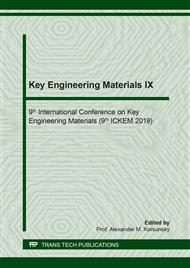[1]
IEA, Key world energy statistics, International Energy Agency (IEA), France, (2016).
Google Scholar
[2]
L. Pérez-Lombard, J. Ortiz, C. Pout, A review on buildings energy consumption information, Energy and Buildings 40(3) (2008) 394-398.
DOI: 10.1016/j.enbuild.2007.03.007
Google Scholar
[3]
S.A. Memon, Phase change materials integrated in building walls: A state of the art review, Renewable and Sustainable Energy Reviews 31(0) (2014) 870-906.
DOI: 10.1016/j.rser.2013.12.042
Google Scholar
[4]
M. Alam, H. Jamil, J. Sanjayan, J. Wilson, Energy saving potential of phase change materials in major Australian cities, Energy and Buildings 78 (2014) 192-201.
DOI: 10.1016/j.enbuild.2014.04.027
Google Scholar
[5]
M. Saffari, A. de Gracia, C. Fernández, L.F. Cabeza, Simulation-based optimization of PCM melting temperature to improve the energy performance in buildings, Applied Energy 202 (2017) 420-434.
DOI: 10.1016/j.apenergy.2017.05.107
Google Scholar
[6]
X. Mi, R. Liu, H. Cui, S.A. Memon, F. Xing, Y. Lo, Energy and economic analysis of building integrated with PCM in different cities of China, Applied Energy 175 (2016) 324-336.
DOI: 10.1016/j.apenergy.2016.05.032
Google Scholar
[7]
H.M. Taleb, S. Sharples, Developing sustainable residential buildings in Saudi Arabia: A case study, Applied Energy 88(1) (2011) 383-391.
DOI: 10.1016/j.apenergy.2010.07.029
Google Scholar
[8]
G.K. Kumar, S. Saboor, T. Babu, Study of Various Glass Window and Building Wall Materials in Different Climatic Zones of India for Energy Efficient Building Construction, Energy Procedia 138 (2017) 580-585.
DOI: 10.1016/j.egypro.2017.10.163
Google Scholar
[9]
M. Dabaieh, O. Wanas, M.A. Hegazy, E. Johansson, Reducing cooling demands in a hot dry climate: A simulation study for non-insulated passive cool roof thermal performance in residential buildings, Energy and Buildings 89 (2015) 142-152.
DOI: 10.1016/j.enbuild.2014.12.034
Google Scholar
[10]
P.C. Tabares-Velasco, C. Christensen, M. Bianchi, Verification and validation of EnergyPlus phase change material model for opaque wall assemblies, Building and Environment 54 (2012) 186-196.
DOI: 10.1016/j.buildenv.2012.02.019
Google Scholar
[11]
M. Saffari, A. de Gracia, S. Ushak, L.F. Cabeza, Economic impact of integrating PCM as passive system in buildings using Fanger comfort model, Energy and Buildings 112 (2016) 159-172.
DOI: 10.1016/j.enbuild.2015.12.006
Google Scholar
[12]
J.S. Sage-Lauck, D.J. Sailor, Evaluation of phase change materials for improving thermal comfort in a super-insulated residential building, Energy and Buildings 79 (2014) 32-40.
DOI: 10.1016/j.enbuild.2014.04.028
Google Scholar
[13]
D. Pan, M. Chan, S. Deng, Z. Lin, The effects of external wall insulation thickness on annual cooling and heating energy uses under different climates, Applied Energy 97 (2012) 313-318.
DOI: 10.1016/j.apenergy.2011.12.009
Google Scholar
[14]
B. Nghana, F. Tariku, Phase change material's (PCM) impacts on the energy performance and thermal comfort of buildings in a mild climate, Building and Environment 99 (2016) 221-238.
DOI: 10.1016/j.buildenv.2016.01.023
Google Scholar
[15]
E. Solgi, S. Memarian, G. Nemati Moud, Financial viability of PCMs in countries with low energy cost: A case study of different climates in Iran, Energy and Buildings 173 (2018) 128-137.
DOI: 10.1016/j.enbuild.2018.05.028
Google Scholar
[16]
J. Lei, J. Yang, E.-H. Yang, Energy performance of building envelopes integrated with phase change materials for cooling load reduction in tropical Singapore, Applied Energy 162 (2016) 207-217.
DOI: 10.1016/j.apenergy.2015.10.031
Google Scholar


